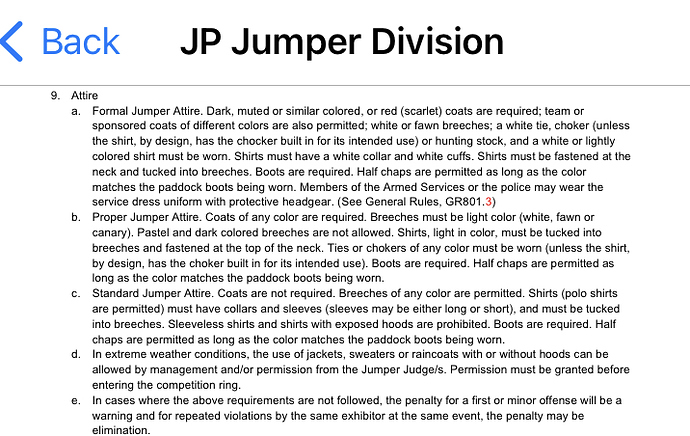I was involved with a group that ran local horse shows for years. No rating, not even county-level, but often attended by local people who did show at higher-level shows because it was an easy, cheap outing. Over the years at various times I managed shows, worked in the show office, measured ponies, wrote and re-wrote rules, hired judges, set courses, directed our all-Marine ring crew while they set courses, watered rings, kind of you name it.
LSS, I agree with the concept of the judge’s decision is final for something like this that falls under the purvey of what they are supposed to be judging. I would have fought my board pretty hard on this one.
I don’t know about this local circuit, but our shows didn’t have stewards (the show manager was the de facto steward), and often hired non-USEF judges. But we did say that we deferred to USEF rules unless otherwise stated in our rules, as do a number of shows and circuits out here. So IMHO, you don’t need to have USEF personnel to say you’re using USEF-based rules.
We had a LOT of rules. More pages of rules than the pages that listed the classes and the rules were in tiny print. There were sections of rules, including general rules, class-specific rules, rules for year-end awards, and cross-entry restrictions, We included highlights of certain rules where we were different than some other shows (allowing trot changes in certain classes without penalty, for example) with the packets that went to the judges. People made fun of us at times, but we never had a situation like the OP’s so there you go.
There was a statute of limitations on making claims (mostly bookkeeping-related) related to year-end awards once they’d been posted in the following month’s newsletter (this was awhile ago, but at least the newsletter wasn’t printed on stone tablets), but I don’t remember the exact wording. I’m pretty sure there was a statement about the judge’s decision being final.
One incident concerned someone who showed in an under saddle class with a martingale. Someone pointed it out to the judge (who did happen to be a USEF judge) at the end of the class as the ribbons were being awarded, and he noted that it was going to stand because he had seen the horse without a martingale at an other (rated) show at the same facility a week or two before and “it was fine.” OK and that’s the way it was, year-end points and all.
I also recall an issue with someone showing in a division for which they weren’t eligible that wasn’t noticed until the week after the show. We reassigned the awards and re-calculated the points. But this wasn’t something that the judge was likely to notice as part of judging.
One more note, which is that I’m a huge fan of catching someone before they make the error that might get them eliminated. See someone going into a flat class with a martingale or a hunter round with wraps. Step up, say something, and offer to help. There was a fuss with the young jumper final series at the Oaks last fall. I don’t remember the details, but it was something to do with the horse’s attire that would have been painfully noticeable to anyone present. Maybe it was polos on the hind legs–the young jumper rules are pretty particular about that, and her polos were a bright color. Anyhow, they let her show over the week like this and no one said anything. No judges, stewards, competitors, or casual observers. She won the final day. They took photos. Then, a day or two later, they handed down the decision that her horse’s attire wasn’t within specs and they took everything away. Sorry, but IMHO that’s just mean.

 .
.
